Cincinnati is the third-largest city in Ohio. It is also the oldest major city in the Buckeye State (a major city is defined by a population over 100,000). Here’s a look at the location of this historic city, along with its climate, geography, culture, and much more.
Where Is Cincinnati Located on the Map?
Cincinnati is situated on the Ohio River in extreme southwestern Ohio. It is the southernmost of Ohio’s six major cities.
How Far Is Cincinnati from Other Major Cities in Ohio?
Here’s a look at the distances from Cincinnati to the other major cities in Ohio.
| City | Distance | Highway Miles |
|---|---|---|
| Columbus | 100 miles | 107 miles |
| Cleveland | 218 miles | 248 miles |
| Toledo | 183 miles | 202 miles |
| Akron | 209 miles | 232 miles |
| Dayton | 48 miles | 54 miles |
Cincinnati is located in a tri-state area. Here are the distances from Cincinnati to some major cities neighboring Kentucky and Indiana.
| City | Distance | Highway Miles |
|---|---|---|
| Indianapolis, Indiana | 99 miles | 109 miles |
| Louisville, Kentucky | 90 miles | 100 miles |
| Lexington, Kentucky | 74 miles | 83 miles |
The Geography of Cincinnati
Cincinnati sits at 482 feet above sea level. The highest point in the city is Mount Airy, which rises to 959 feet above sea level.
The topography of Cincinnati is uneven, to say the least. When ice age glaciers melted, the meltwater carved through the region, creating deep valleys and ravines. Cincinnati is famously known as the City of Seven Hills, but it is actually more of a city with many valleys than a city with seven hills.
The whole “seven hills” moniker was actually just a marketing device in the nineteenth century. The plan was to link Cincinnati to a much larger and more famous city with seven hills: Rome. Cincinnati’s name comes from the Roman statesman and military hero Cincinnatus.
The Seven Hills marketing plan was hatched in the 1880s when Cincinnati was far smaller than it is now. The original seven hills included:
- Mount Adams
- Walnut Hills
- Mount Auburn
- Vine Street Hill
- College Hill
- Fairmount
- Mount Harrison (now known as Price Hill)
Today, after years of annexation and growth, there are far more than seven hills in Cincinnati (again, the term “hills” isn’t always topographically accurate, but we won’t quibble). Somehow, though, the “seven hills” label has lived on for over 140 years despite its inaccuracies.

The “hills” are so synonymous with Cincinnati that some of the city’s neighborhoods include it in their name, such as Walnut Hills.
©Warren LeMay from Cincinnati, OH, United States / CC0 – License
What Is the Climate in Cincinnati?
Using the Köppen climate classifications, Cincinnati lies at the southern tip of the humid continental climate zone. It borders the humid subtropical climate zone.
Winters are cold and dreary. January is the coldest month of the year, with an average high temperature of 36°F. The city receives a little over 23 inches of snow in an average season. Ice events such as freezing rain are also fairly common, as winter temperatures often hover at or just above the freezing point.
Summers in Cincinnati are hot and can feature tropical levels of humidity. The average high temperature in July, the hottest month of the year, is 86°F. The city averages 22 days a year with temperatures in excess of 90°F.
Is Cincinnati a Good Place to Live?
While Columbus is the largest city in Ohio by far, Cincinnati has a more populous metropolitan area. Cincinnati’s metro includes eighteen counties in Ohio, Kentucky, and Indiana. The U.S. Census Bureau reported a 2022 population of 2.256 million people in Greater Cincinnati, making it the 30th largest metro area in the nation. Clearly, a lot of people believe Cincinnati is a good place to live.
U.S. News and World Report recently ranked Cincinnati as Ohio’s most livable city and the 50th best city to call home in the United States. The methodology used to compile this report considered the quality of education, commuter index, crime rate, quality and availability of health care, air quality index, and other factors. Cincinnati’s low cost of living, along with its schools, museums, restaurants, Fortune 500 companies, and professional sports teams, all helped the city land the top spot in Ohio in this report.
SmartAsset recently ranked Cincinnati as the best city in the nation for recent college graduates, a title it has retained for four years straight. The city had the fourth-highest “fun score” and the fifth-highest “affordability score.” Those scores, combined with job availability and other factors, gave the city the highest overall rating for new college graduates of any city in the U.S.
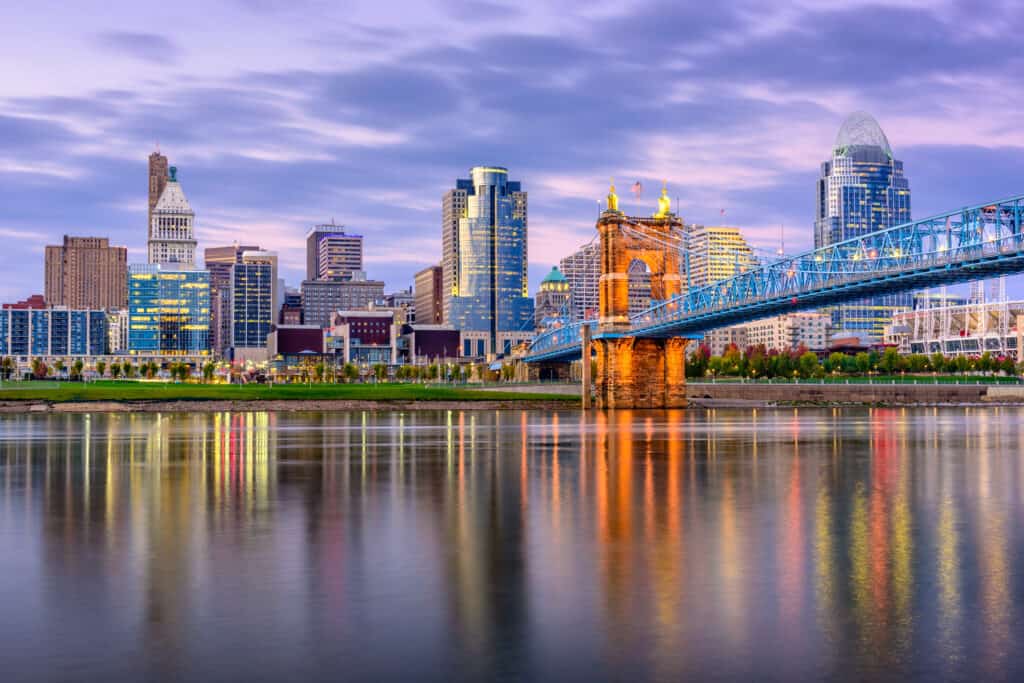
Cincinnati is home to 309,000 people and a metro population of over 2.2 million.
©Sean Pavone/Shutterstock.com
What Is Cincinnati Famous For?
On the surface, Cincinnati looks like a typical Midwestern city. Looks can be deceiving, though. The city has a unique vibe and signature elements that give it its own identity. Here are a few things that Cincinnati is known for.
Chili
One visit to Cincinnati will quickly reveal the city’s obsession with chili. Chili parlors are as ubiquitous in Cincinnati as pizza parlors are in New York City.
Texas may be famous for its chili, but Cincinnati chili is a completely different concoction. It is a Greek-inspired meat sauce with nutmeg, cinnamon, cloves, and other spices. It is served over spaghetti and is covered with a mound of cheddar cheese. This chili, spaghetti, and cheese combination is known as a 3-way…a name that is sure to sound strange to non-Cincinnatians!
The chili is also served on hot dogs. Diners can choose to add onions and/or mustard if they wish. The chili-slathered hot dogs are then covered with that same delicious cheese that tops a 3-way, creating the iconic Cincinnati cheese coney. The New York Times recently ranked the cheese coney as one of the fifteen best hot dogs in America, holding its own against the famous Chicago Dog, New York Dog, and others.
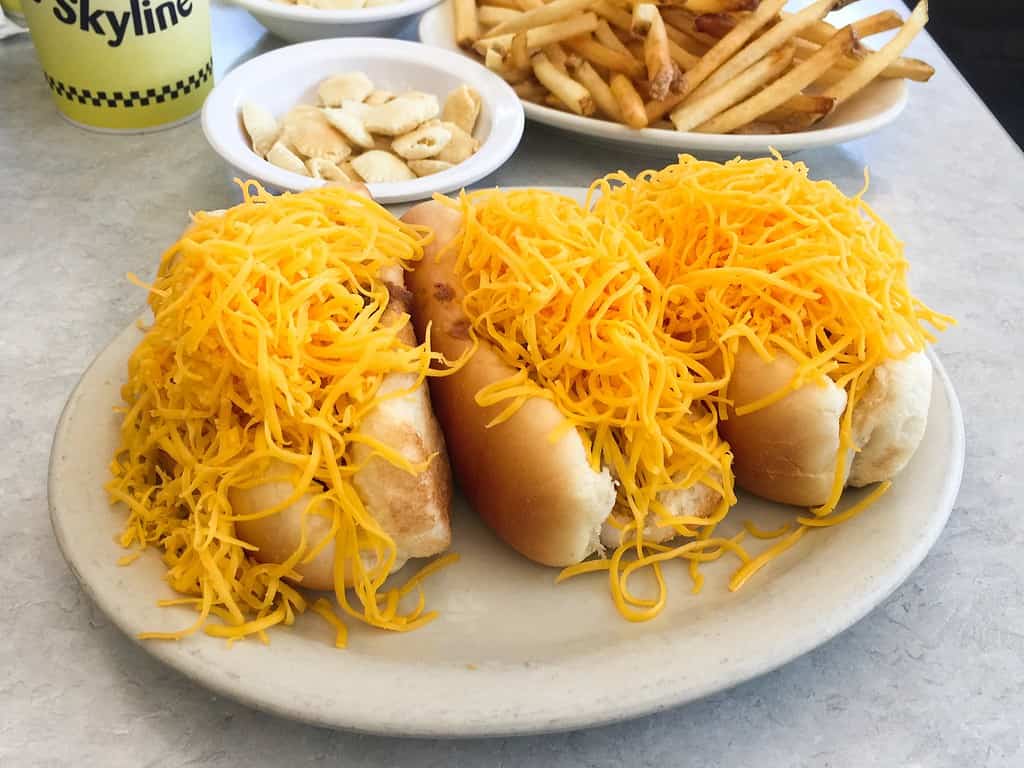
The Cincinnati cheese coney was selected as one of the most iconic hot dogs in the nation.
©EEJCC / CC BY-SA 4.0 – License
Baseball
Cincinnati is the birthplace of professional baseball. The Cincinnati Red Stockings was the first professional baseball team formed in 1869. The Major League Baseball team, now known simply as the Cincinnati Reds, is deeply embedded into the history and culture of the city. The Reds are so important to Cincinnatians that the first day of the Major League Baseball season is an unofficial holiday. The Opening Day parade in Downtown Cincinnati is one of the biggest events of the year. Thousands of people take off work or school (or call in sick…cough, cough) to take part in the festivities.
The Reds play in Great American Ball Park, located on the banks of the Ohio River. In its long history, the team has won five World Series championships in 1919, 1940, 1975, 1976, and 1990. The Reds have also won nine National League pennants and ten division titles.
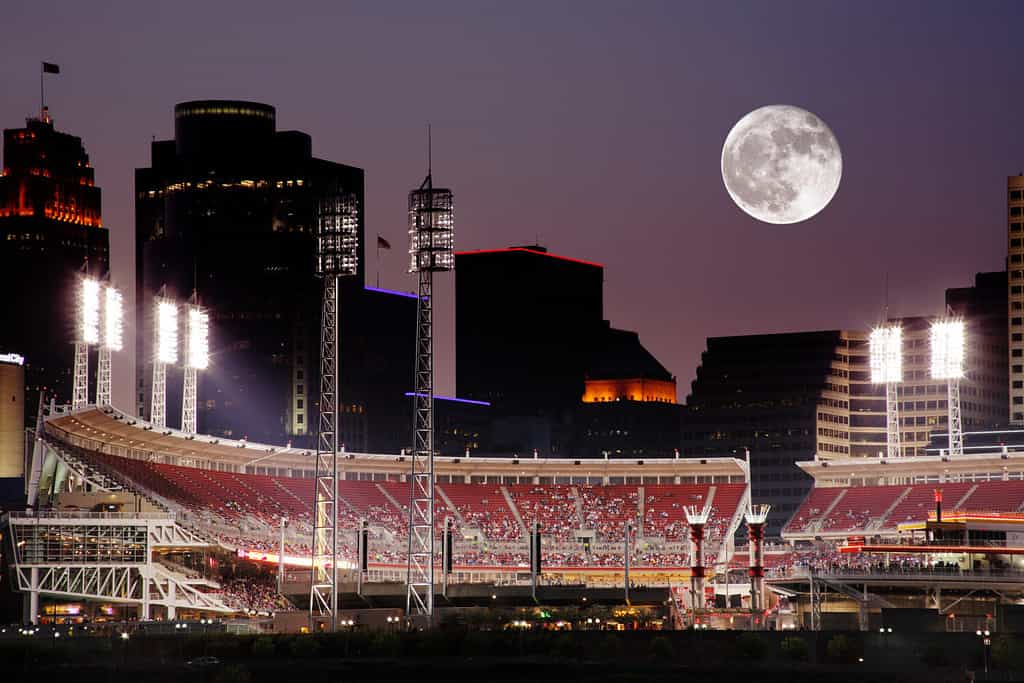
The Cincinnati Reds play at Great American Ball Park in downtown Cincinnati.
©Doug Lemke/Shutterstock.com
German Heritage
While Cincinnati’s earliest settlers were English and Scottish, the city’s German population skyrocketed in the 1840s. By the 1850s, the German language was featured in four Cincinnati newspapers and was used in church services, classrooms, and businesses. The city was also burgeoning with breweries, to the point where it was once known as the Beer Capital of the World. The city is still home to more than 50 breweries.
Cincinnati’s German roots are easy to see today. For example, goetta (pronounced get-uh) is a Cincinnati staple. It is a German dish that features pork and beef mashed together with steel-cut oats and various spices. It was originally a peasant dish created to save money and stretch limited ingredients. Today, it is synonymous with Cincinnati. There is even an annual Goettafest held in Northern Kentucky each year.
Cincinnati’s German roots are never seen more vividly than during Oktoberfest Zinzinnati. The Oktoberfest celebration was born in Munich, Germany in 1810. It was originally a celebration of the marriage of Ludwig I, Prince of Bavaria, to Princess Therese von Sachsen-Hildburghausen. The celebration became an annual tradition of oompah bands, polka dancing, parades, food, and, of course, beer.
Oktoberfest Zinzinnati is the largest Oktoberfest celebration outside of Germany. Over 700,000 people attend the annual event in Cincinnati. Revelers enjoy 80,500 bratwursts, 56,250 sausages, 23,000 soft pretzels, 3,600 pounds of sauerkraut, and 702 pounds of Limburger cheese during the four-day party. Events include the running of the weiners (a race of dachshunds), bratwurst eating competitions, and the world’s largest chicken dance.
Neighborhoods
There are 52 neighborhoods inside Cincinnati’s city limits. The neighborhoods all have their own unique architecture, character, and vibe. These communities range from the eclectic and historic Over-the-Rhine neighborhood to the picturesque hilltop community of Mount Adams to the quiet riverside neighborhood of Columbia-Tusculum. Traveling between these neighborhoods can feel like a trip between entirely different cities.
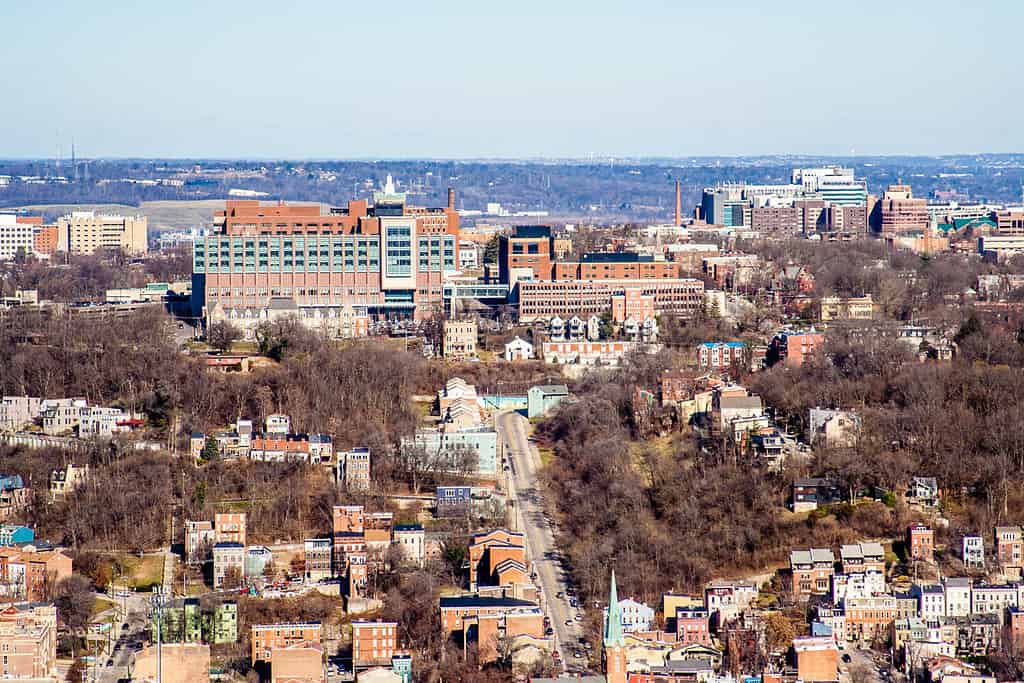
There are 52 distinct neighborhoods in Cincinnati.
©Stephanie A Sellers/Shutterstock.com
Museums
Cincinnati has a wealth of opportunities for museum lovers. No matter what you want to learn and experience, there is a Cincinnati museum for you. The Cincinnati Museum Center at the historic Union Terminal train station features the Cincinnati History Museum, the Cincinnati History Library and Archives, The Children’s Museum, and the Museum of Natural History & Science.
The city also features the Taft Museum of Art, the National Underground Railroad Freedom Center, the Cincinnati Art Museum, the American Sign Museum, the Cincinnati Fire Museum, the Contemporary Arts Center, the Cincinnati Reds Hall of Fame and Museum, and many more.
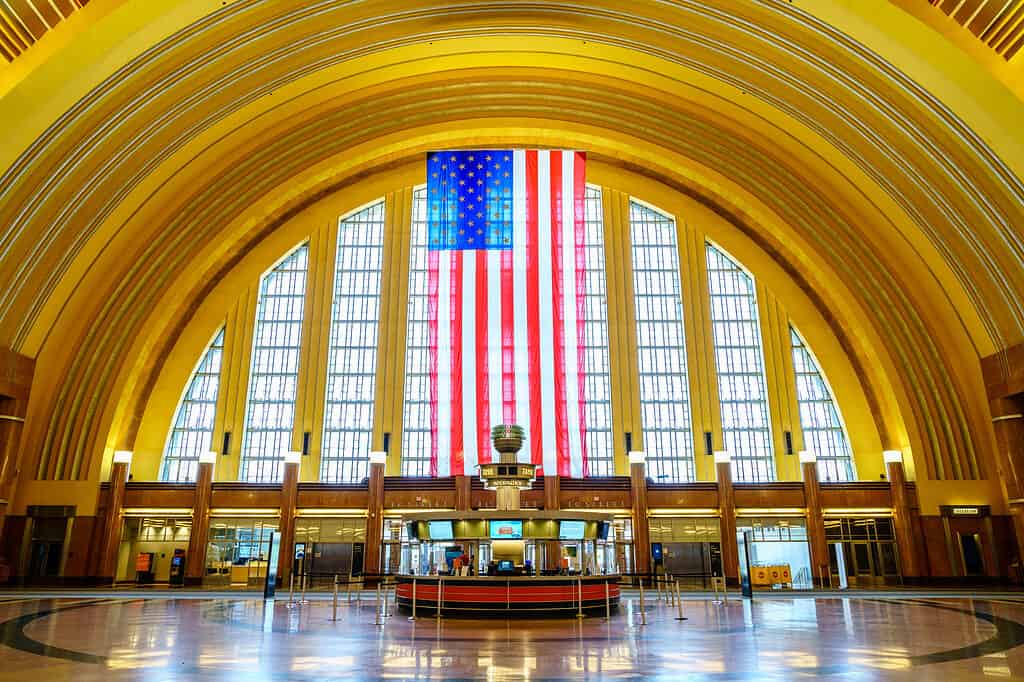
Union Terminal is home to multiple museums.
©Alexey Stiop/Shutterstock.com
Football and Soccer
While the teams don’t share the longstanding tradition of the Reds, Cincinnati’s other major league teams have become part of the city’s collective consciousness. The Cincinnati Bengals became the city’s National Football League franchise in 1967. FC Cincinnati is the newest addition to Cincinnati’s major league sports. The soccer franchise was founded as a Division II team in 2016 and then moved to Major League Soccer in 2019. Neither team has won a championship yet, but both seem poised to be serious contenders in the near future.
Cincinnati Zoo
The city’s zoo opened in 1875, making it one of the oldest zoos in the U.S. The Reptile House at the zoo is the oldest zoo building in the nation. The Cincinnati Zoo & Botanical Garden was named a national landmark in 1987 due to the unique architecture of the Elephant and Reptile Houses.
More recently, the zoo received international recognition when Fiona, the Nile hippo, was born in 2017. The female calf was born six weeks premature and weighed only 29 pounds. She is the smallest hippo to ever survive and can be seen in Hippo Cove at the zoo.

The Cincinnati Zoo’s Reptile House is the oldest zoo building in the United States.
©Joe D. Good / CC BY-SA 4.0 – License
Art
Along with the city’s many art museums, Cincinnati is also home to countless other opportunities to enjoy the arts. Music Hall is one of the city’s most iconic buildings. The hall was built in 1878 and was named a National Historic Landmark in 1975. It is the home of the Cincinnati Ballet, Cincinnati Symphony Orchestra, Cincinnati Pops Orchestra, Cincinnati Opera, and the May Festival Chorus.
Cincinnati is also home to the Playhouse in the Park, Taft Theater, and many other performance venues.
BLINK is a bi-annual celebration of illuminated art, including “large-scale projection mapping, murals, and interactive light sculptures from around the globe.” Over two million people were part of the last BLINK event in 2022.
But the arts scene isn’t limited to these venues and events. A simple stroll around the city is all it takes to see the arts culture is alive and well. For example, ArtWorks Cincinnati has created over 200 public murals throughout the city of Cincinnati and its neighborhoods.
Fountain Square in the middle of the city features a historic fountain sculpture. The Tyler Davidson Fountain was dedicated in 1871. Since then, the city has grown up around it. Today, it is the centerpiece of Fountain Square, the hub of activity, events, and celebrations in Downtown Cincinnati.

The Tyler Davidson Fountain in the heart of downtown is an artistic piece that has come to symbolize the city of Cincinnati.
©iStock.com/Kirkikis
The History of Cincinnati
Founding
In 1788, settlers Matthias Denman, Robert Patterson, and Israel Ludlow purchased 800 acres from John Cleves Symmes. The land was located at the confluence of the Licking and Ohio Rivers. The men named the initial town Losantiville.
One year later, Fort Washington was built to protect settlers moving into the area. The fort housed about 300 soldiers, more than doubling the population of Losantiville.
Arthur St. Clair established Hamilton County in 1790 and named Losantiville the county seat. However, Clair, who was the governor of the Northwest Territory, detested the town’s name. He changed it to Cincinnati.
Growth as a River City
Cincinnati grew into a major city mainly because of its strategic location on the Ohio River. Shipping became a major industry in the city. Steamboats were common sights along the river. Plus, the construction of the Erie and Miami Canals vastly improved travel from western Ohio to Cincinnati, which grew the city’s economy exponentially.
Along with crops, farmers also shipped their livestock to Cincinnati. The city became a huge meat-processing center, earning it the nickname “Porkopolis.” Though it is no longer the center of meat processing in the nation, Cincinnati still remembers this heritage through events such as the annual Flying Pig Marathon.
The city’s location on the Ohio River made it a main stop on the Underground Railroad in the lead-up to the Civil War. The river crossing from Kentucky to Cincinnati was the most heavily traveled route on the Underground Railroad. Some 30,000 people escaped slavery through the city’s vast abolitionist network.
The Ohio River crossing from Kentucky to Cincinnati became the most heavily traveled route of the Underground Railroad. Some 30,000 people escaped slavery through the city’s abolitionist network.
By the end of the 1800s, Cincinnati was the largest city in Ohio and the most densely populated city in the United States.
Cincinnati Presidents
Four U.S. presidents have ties to the Greater Cincinnati area.
- William Henry Harrison, the ninth U.S. president, was from North Bend, a western suburb of Cincinnati. Harrison was buried in North Bend after he died in 1841.
- Ulysses S. Grant, the nation’s 18th president, was born along the banks of the Ohio River in Point Pleasant and spent part of his childhood in Georgetown. Both Ohio towns are southeast of Cincinnati.
- Benjamin Harrison, the 23rd president and the grandson of William Henry Harrison, was also from North Bend.
- William Howard Taft, the 27th president of the United States, was born and raised in Cincinnati. His childhood home is a National Historic Site and is operated by the National Park Service.
The photo featured at the top of this post is © iStock.com/RudyBalasko
Thank you for reading! Have some feedback for us? Contact the AZ Animals editorial team.







